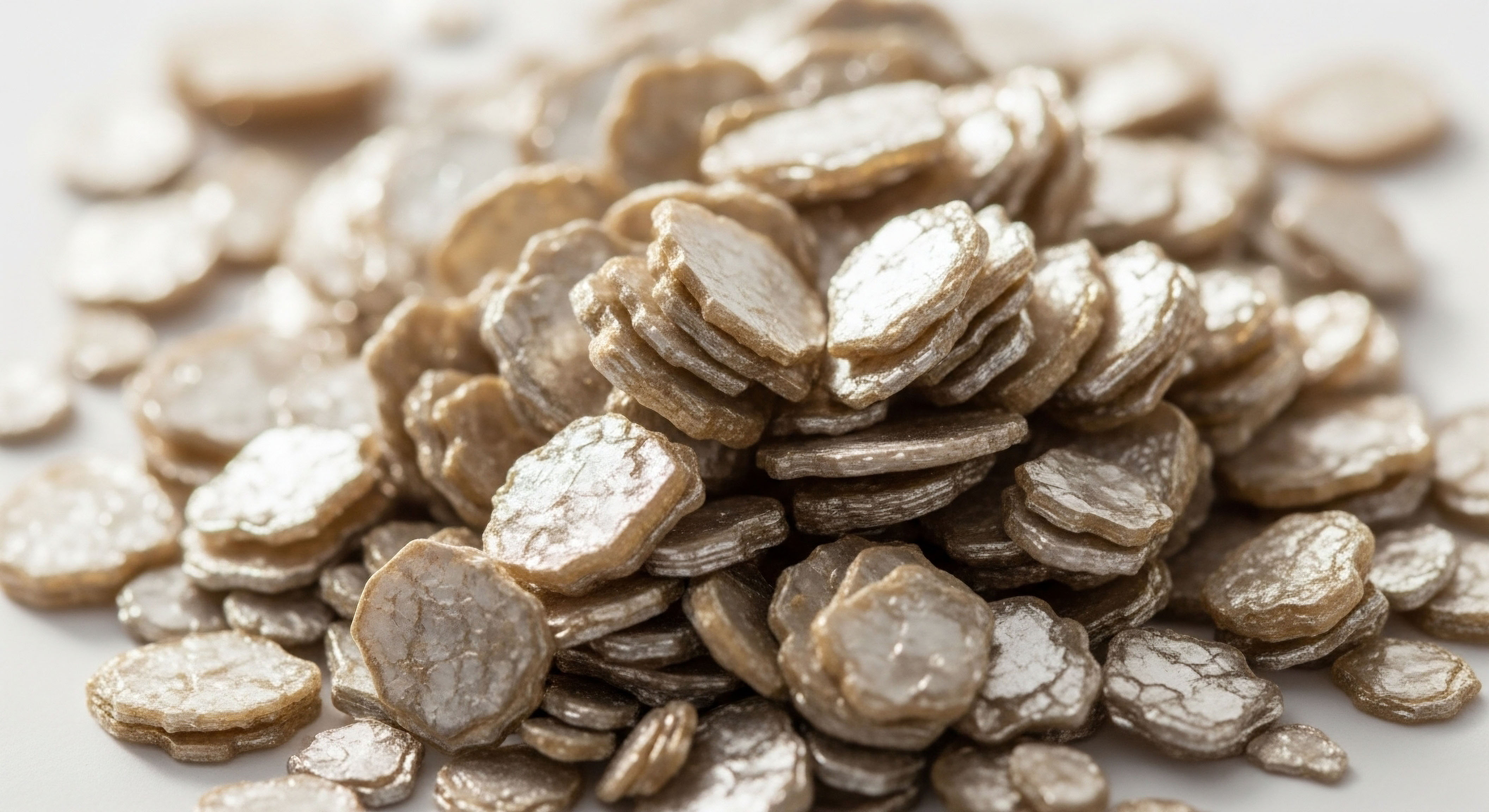

Fundamentals
Experiencing shifts in one’s physical and emotional landscape can bring about a sense of disquiet, particularly when the changes relate to fundamental aspects of vitality and self. Many individuals who have navigated the path of testosterone optimization protocols, often referred to as hormonal recalibration, arrive at a point where they consider the restoration of their body’s inherent functions, including fertility.
This personal journey, marked by a desire to reclaim biological autonomy, is deeply understood. The process of re-establishing natural sperm production, known as spermatogenesis, after a period of exogenous testosterone administration, is a significant consideration for many.
Understanding the body’s intricate communication networks provides clarity. The central control system for male reproductive function is the Hypothalamic-Pituitary-Gonadal (HPG) axis. This sophisticated feedback loop orchestrates the production of testosterone and sperm. The hypothalamus, a region within the brain, initiates the process by releasing Gonadotropin-Releasing Hormone (GnRH).
This chemical messenger then signals the pituitary gland, a small but mighty organ situated at the base of the brain, to secrete two crucial hormones ∞ Luteinizing Hormone (LH) and Follicle-Stimulating Hormone (FSH).
LH travels through the bloodstream to the testes, stimulating specialized cells called Leydig cells to produce testosterone. Concurrently, FSH acts upon the Sertoli cells within the testes, which are essential for supporting and nourishing developing sperm. When external testosterone is introduced, as in a testosterone optimization protocol, the body’s HPG axis perceives an abundance of circulating testosterone.
This leads to a natural suppression of GnRH, LH, and FSH production, a phenomenon known as negative feedback. The testes, no longer receiving the necessary signals from the pituitary, reduce their own testosterone synthesis and, critically, sperm production.
Reclaiming natural sperm production after external testosterone support involves reactivating the body’s central hormonal communication system.
The cessation of exogenous testosterone initiates a period where the HPG axis must awaken from its suppressed state. This awakening is not instantaneous; it involves a gradual recalibration of the delicate hormonal balance. The body needs time to recognize the absence of external testosterone and subsequently increase its own GnRH, LH, and FSH output. This intricate biological dance sets the stage for the resumption of spermatogenesis.

The Body’s Internal Messaging System
Consider the HPG axis as a sophisticated internal messaging system. When you introduce an external message (exogenous testosterone), the system’s internal senders (hypothalamus and pituitary) receive a signal that the message is already being delivered in ample supply. Consequently, they reduce their own output. When the external message ceases, the internal senders must gradually increase their activity to resume full communication. This re-engagement is a biological process that unfolds over time, influenced by various individual factors.

Why Does Spermatogenesis Pause?
Spermatogenesis, the continuous process of sperm creation, requires a specific hormonal environment within the testes, primarily driven by FSH and local testosterone production. When external testosterone is administered, it replaces the need for the testes to produce their own testosterone. This replacement, combined with the suppression of FSH, directly impacts the delicate machinery of sperm production. The testicular environment becomes less conducive to generating new sperm cells, leading to a significant reduction or complete cessation of spermatogenesis.


Intermediate
Navigating the pathway to spermatogenesis recovery post-testosterone optimization protocols requires a targeted approach, often involving specific pharmacological agents designed to stimulate the HPG axis. The objective is to gently nudge the body’s intrinsic systems back into full operation, encouraging the testes to resume their dual roles of testosterone synthesis and sperm production. This phase of biochemical recalibration is a testament to the body’s remarkable capacity for adaptation and restoration.
The typical timeline for spermatogenesis recovery is not a fixed duration; rather, it represents a spectrum influenced by individual physiological responses and the duration and dosage of prior testosterone administration. Generally, a noticeable return of sperm production can begin within several months, but full recovery to pre-treatment levels may extend beyond a year for many individuals.
Some clinical observations suggest that while sperm count may begin to rise within three to six months, optimal motility and morphology might require a longer period of up to 12 to 18 months, or even longer in some cases.
Spermatogenesis recovery post-testosterone support is a variable process, often taking months to over a year for full restoration.

Protocols for Re-Establishing Spermatogenesis
Several agents are commonly employed in a post-testosterone optimization protocol aimed at restoring fertility. These agents work through distinct mechanisms to re-engage the HPG axis:
- Gonadorelin ∞ This synthetic analog of GnRH acts directly on the pituitary gland, prompting it to release LH and FSH. Administered via subcutaneous injections, typically twice weekly, Gonadorelin mimics the natural pulsatile release of GnRH, thereby stimulating the entire HPG axis from the top down. This direct stimulation helps to awaken the pituitary’s signaling capabilities, which in turn encourages testicular function.
- Tamoxifen ∞ A selective estrogen receptor modulator (SERM), Tamoxifen primarily blocks estrogen’s negative feedback on the hypothalamus and pituitary. By occupying estrogen receptors in these brain regions, Tamoxifen prevents estrogen from signaling the HPG axis to reduce LH and FSH production. This removal of inhibition leads to an increase in endogenous LH and FSH, thereby stimulating testicular testosterone and sperm production.
- Clomid (Clomiphene Citrate) ∞ Similar to Tamoxifen, Clomid is also a SERM. It works by blocking estrogen receptors in the hypothalamus, which then perceives lower estrogen levels. In response, the hypothalamus increases GnRH secretion, leading to elevated LH and FSH from the pituitary. This cascade directly stimulates the testes to produce more testosterone and resume spermatogenesis.
- Anastrozole ∞ This aromatase inhibitor is sometimes included, particularly if estrogen levels become elevated during the recovery process. High estrogen can exert a negative feedback effect on the HPG axis, counteracting the desired stimulation. By reducing the conversion of testosterone to estrogen, Anastrozole helps maintain a more favorable hormonal environment for HPG axis recovery and spermatogenesis.
The choice and combination of these agents are highly individualized, determined by baseline hormonal profiles, the duration of prior testosterone administration, and the patient’s specific recovery goals. Regular monitoring of LH, FSH, testosterone, and estrogen levels, alongside serial semen analyses, guides the adjustment of these protocols.

Understanding the Recovery Trajectory
The recovery trajectory is not always linear. Initial improvements in hormonal markers may precede significant changes in sperm parameters. The process of spermatogenesis itself is lengthy, taking approximately 72-74 days for a sperm cell to fully mature. This biological reality means that even after the HPG axis is successfully stimulated, it takes time for new sperm to be produced and become detectable in semen analysis.
Factors such as the individual’s age, the duration of prior testosterone optimization, the dosage used, and any pre-existing testicular conditions can influence the speed and completeness of recovery. Younger individuals with shorter durations of testosterone use often experience a more rapid and complete return of spermatogenesis. Conversely, prolonged suppression or older age may necessitate longer and more intensive recovery protocols.
The table below provides a general overview of the expected phases of recovery, acknowledging that individual variations are substantial.
| Recovery Phase | Approximate Timeline | Key Hormonal Changes | Spermatogenesis Status |
|---|---|---|---|
| Initial Re-engagement | 1-3 Months | LH, FSH begin to rise; Testosterone may show initial increase. | Minimal to no sperm production; HPG axis awakening. |
| Early Production | 3-6 Months | LH, FSH continue to rise; Testicular testosterone production increases. | Spermatozoa may appear in semen analysis, often with low count/motility. |
| Progressive Improvement | 6-12 Months | Hormonal levels stabilize closer to baseline; Testicular function improves. | Sperm count, motility, and morphology gradually improve. |
| Optimal Restoration | 12-18+ Months | Hormonal balance re-established; Testicular size and function optimized. | Sperm parameters approach pre-treatment levels for many individuals. |


Academic
The deep endocrinology governing spermatogenesis recovery post-exogenous androgen administration presents a complex interplay of neuroendocrine signaling, cellular biology, and testicular physiology. A comprehensive understanding requires dissecting the molecular mechanisms by which the HPG axis reasserts its regulatory control and how the seminiferous tubules, the sites of sperm production, regain their full functional capacity.
The timeline for this recovery is not merely a matter of elapsed days; it is a dynamic biological process influenced by the degree of Leydig cell desensitization, Sertoli cell function, and the integrity of the germinal epithelium.
The suppression induced by exogenous testosterone is primarily mediated through the negative feedback on GnRH pulsatility at the hypothalamic level and direct inhibition of LH and FSH secretion from the anterior pituitary. Prolonged suppression can lead to a state of functional hypogonadotropic hypogonadism, where the testes become quiescent due to a lack of trophic stimulation. The recovery process, therefore, necessitates a reversal of this suppression, demanding a robust and sustained increase in endogenous gonadotropin secretion.
Spermatogenesis recovery involves complex neuroendocrine and cellular recalibration, influenced by the duration of prior hormonal suppression.

Molecular Mechanisms of HPG Axis Recalibration
The re-establishment of GnRH pulsatility is the initial, critical step. GnRH neurons in the hypothalamus exhibit an intrinsic pulsatile activity, which is crucial for stimulating pituitary gonadotrophs. Exogenous androgens disrupt this pulsatility. Agents like Gonadorelin directly provide this pulsatile stimulation, bypassing the hypothalamic suppression.
Conversely, SERMs such as Tamoxifen and Clomiphene Citrate act by competitively binding to estrogen receptors in the hypothalamus and pituitary. This action prevents estrogen from inhibiting GnRH and gonadotropin release, thereby disinhibiting the HPG axis. The resulting increase in LH stimulates Leydig cells to produce testosterone, while FSH directly supports Sertoli cell function and spermatogenesis.
The responsiveness of Leydig cells to LH stimulation is a key determinant of recovery speed. Chronic suppression can lead to a reduction in LH receptor expression or post-receptor signaling efficiency, requiring a period of resensitization. Similarly, Sertoli cells, which form the blood-testis barrier and provide essential support for germ cell development, depend on FSH and high local testosterone concentrations. The re-establishment of these optimal microenvironments within the seminiferous tubules is paramount for the progression of spermatogenesis.

Cellular Dynamics of Spermatogenesis Restoration
Spermatogenesis is a highly organized process involving mitotic proliferation of spermatogonia, meiotic division of spermatocytes, and spermiogenesis (the transformation of spermatids into mature spermatozoa). Each stage is tightly regulated by hormonal and paracrine factors. FSH primarily influences the early stages of spermatogonia proliferation and differentiation, while testosterone is crucial for the later stages of meiosis and spermiogenesis.
The recovery timeline reflects the time required for these cellular processes to resume and for new sperm to traverse the seminiferous tubules and epididymis. The cycle of the seminiferous epithelium in humans is approximately 16 days, and it takes about 4.5 cycles for a spermatogonium to develop into a spermatozoon.
This intrinsic biological clock dictates that even with optimal hormonal stimulation, a minimum of 72-74 days is required for the first wave of mature sperm to appear in the ejaculate. Subsequent improvements in sperm count, motility, and morphology often continue for many months as the testicular environment normalizes and the full complement of germ cells is restored.
Clinical studies have documented wide variations in recovery times. Factors influencing this variability include:
- Duration of Testosterone Administration ∞ Longer periods of exogenous testosterone use are generally associated with more prolonged HPG axis suppression and, consequently, a longer recovery period.
- Dosage and Type of Testosterone ∞ Higher doses or more potent forms of testosterone may induce a deeper and more persistent suppression.
- Individual Physiological Variability ∞ Genetic predispositions, baseline testicular function, and overall metabolic health can influence the rate and completeness of recovery.
- Age ∞ Older individuals may experience a slower and less complete recovery due to age-related decline in testicular reserve and HPG axis responsiveness.
- Pre-existing Testicular Conditions ∞ Undiagnosed or pre-existing conditions affecting testicular function (e.g. varicocele, cryptorchidism history, genetic abnormalities) can impede recovery.
The success of a post-testosterone optimization protocol is measured not only by the return of measurable sperm but also by the quality of the sperm produced. Semen analysis parameters, including sperm concentration, total motility, progressive motility, and normal morphology, are critical indicators of fertility potential. The goal is to achieve parameters consistent with natural conception, which may require sustained therapeutic intervention and patient adherence.
The table below illustrates the typical progression of sperm parameters during recovery, based on aggregated clinical data.
| Time Post-Cessation | Sperm Concentration (million/mL) | Total Motility (%) | Normal Morphology (%) |
|---|---|---|---|
| Baseline (Suppressed) | < 1.0 (often azoospermic) | < 5 | < 1 |
| 3-6 Months | 1-10 | 10-30 | 1-3 |
| 6-12 Months | 10-30 | 30-50 | 3-5 |
| 12-18+ Months | 30 (approaching baseline) | 50 (approaching baseline) | 4 (approaching baseline) |
These figures represent averages, and individual results can vary significantly. Some individuals may achieve full recovery within a shorter timeframe, while others may require more extended periods or may not fully return to their pre-treatment fertility status. A personalized approach, guided by consistent monitoring and adjustment of the recovery protocol, is essential for optimizing outcomes.

How Does Prior TRT Duration Affect Recovery?
The length of time an individual has been on testosterone optimization protocols plays a substantial role in the recovery trajectory of spermatogenesis. Shorter durations of exogenous androgen exposure typically correlate with a more rapid and complete return of endogenous testicular function. This is because the HPG axis and the testicular Leydig and Sertoli cells may retain greater sensitivity and responsiveness to gonadotropin stimulation.
Conversely, extended periods of testosterone administration can lead to more profound and persistent suppression of the HPG axis. This prolonged suppression may result in a greater degree of Leydig cell desensitization and potential atrophy of the seminiferous tubules, making the re-initiation of spermatogenesis a more challenging and time-consuming endeavor. The body’s intricate feedback loops become more deeply ingrained in a suppressed state, requiring more sustained and potent stimulation to reawaken.

References
- Nieschlag, Eberhard, and Hermann M. Behre. Andrology ∞ Male Reproductive Health and Dysfunction. Springer, 2010.
- Weinbauer, G. F. and E. Nieschlag. “Spermatogenesis and its hormonal regulation.” Journal of Endocrinology, vol. 170, no. 1, 2001, pp. 119-132.
- Paduch, Darius A. et al. “Testosterone Replacement Therapy and Fertility ∞ A Systematic Review.” Fertility and Sterility, vol. 108, no. 5, 2017, pp. 844-852.
- Khera, Mohit, et al. “A Systematic Review of the Effect of Testosterone Replacement Therapy on Spermatogenesis.” Journal of Sexual Medicine, vol. 15, no. 1, 2018, pp. 1-10.
- Shabsigh, Ridwan, et al. “The Effects of Testosterone Replacement Therapy on Spermatogenesis and Fertility.” Journal of Urology, vol. 199, no. 2, 2018, pp. 529-536.
- Boron, Walter F. and Emile L. Boulpaep. Medical Physiology. Elsevier, 2017.
- Guyton, Arthur C. and John E. Hall. Textbook of Medical Physiology. Elsevier, 2020.

Reflection
Considering your personal health journey, how might understanding the intricate biological systems within your body reshape your approach to well-being? The knowledge presented here about spermatogenesis recovery is not merely clinical information; it is a lens through which to view your own biological resilience. Each individual’s response to hormonal recalibration and subsequent recovery protocols is unique, a testament to the complex symphony of human physiology.
This exploration serves as a starting point, a foundation for deeper conversations with your healthcare team. It prompts a consideration of how personalized guidance, tailored to your specific biological markers and lived experiences, can truly support your goals for vitality and function. The path to reclaiming optimal health is a collaborative one, where scientific understanding meets individual aspiration.



